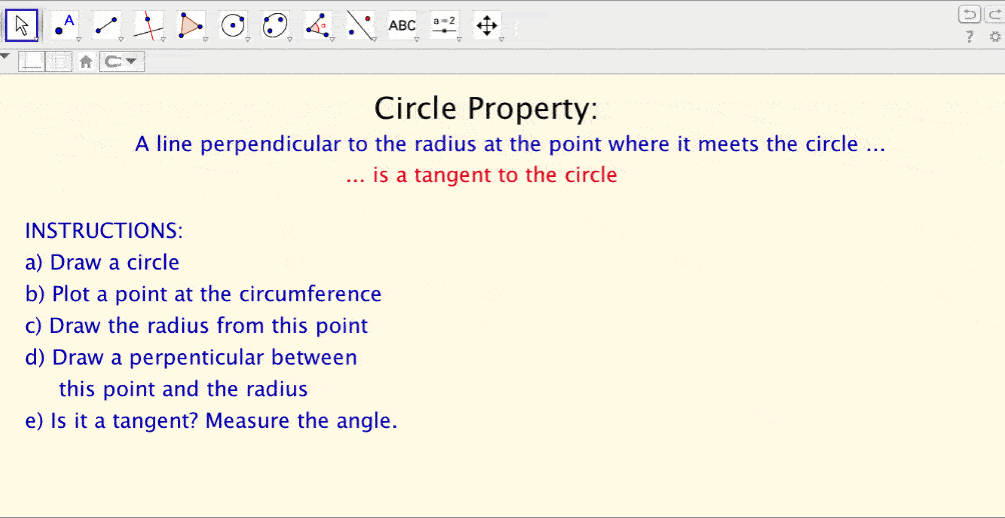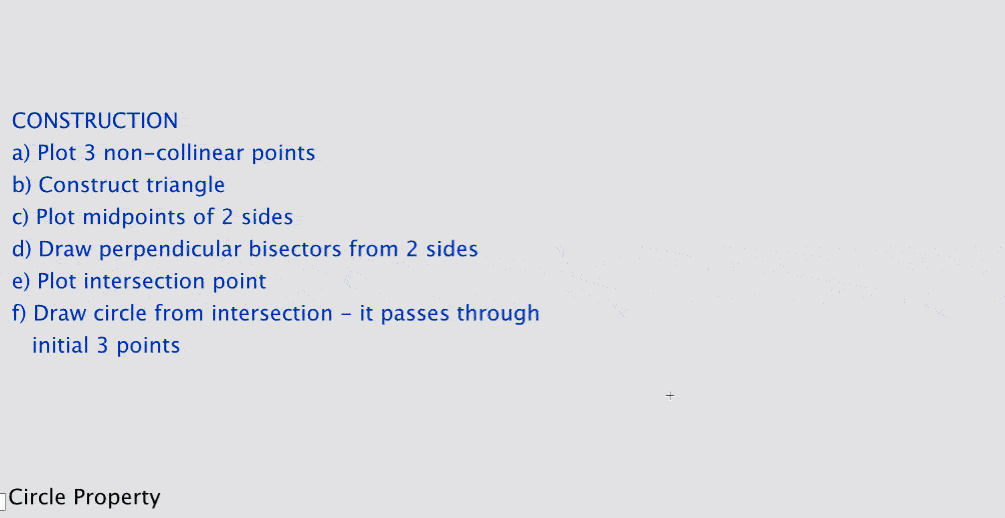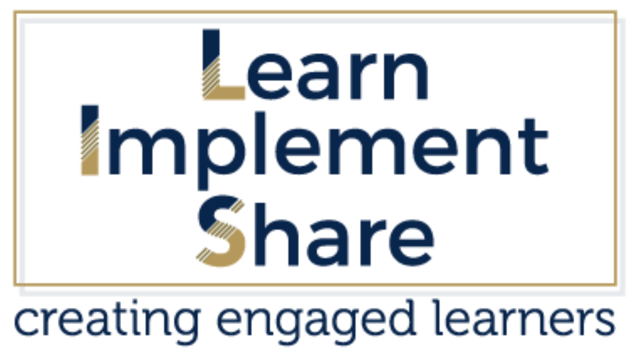Five Tips For Student-Led GeoGebra Tasks
GeoGebra - An ideal tool for middle school and junior high mathematics!
GeoGebra is often wrongly perceived as solely for high school-level calculus and geometry. This article aims to change this perception by promoting its use in middle and junior high mathematics classrooms (in addition to senior).
Despite its popularity, GeoGebra remains underutilised beyond a superficial level by many maths teachers. This is due to misconceptions such as the difficulty of use, the requirement for pedagogical change, and the inappropriateness for lower-level mathematics. In reality, GeoGebra is a potent tool for many topics throughout junior and senior high maths, even when used solely as a demonstration tool. The school mathematics landscape would be in better shape if more mathematics teachers experienced the full potential of GeoGebra. |
In the article Let GeoGebra transform your math teaching we unpack ways in which GeoGebra can enhance student engagement and understanding in mathematics classes.
The simple method of projecting GeoGebra files in class can have an immediate impact.
In this article, however, we will delve into student-led investigations, which require a different teaching approach and careful planning.
The simple method of projecting GeoGebra files in class can have an immediate impact.
In this article, however, we will delve into student-led investigations, which require a different teaching approach and careful planning.
Two Types Of Student-Led Investigations In Which The 5 Tips Apply:
There are two types of investigations - beginner and advanced - for students with different levels of experience and interest in inquiry-based learning.
The Five tips for student-led GeoGebra tasks
- Engage.
- Teach basic skills using self-directed notes or videos.
- Use open-ended investigations.
- Scaffold the investigations.
- Encourage collaboration.
Note: When introducing student-led activities, the potential benefits are high, but so are the risks of failure. Therefore, consider the following:
1. Student Engagement
How engaged are your students? Are they familiar with student-centred activities? Do some students tend to veer off task at the first opportunity? Do you need help with classroom management? If yes, are you hoping that a student-centered GeoGebra investigation will help win them to your cause?
Where disengagement is the norm, it is crucial to understand that introducing technology per se won’t fix the issue. Disengagement can be turned into engagement using a range of strategies, but this is beyond the scope of this article.
The golden rule tends to be ‘the less engaged a class, the greater the need for scaffolding’.
And for motivated and functional students, proceed confidently with student-centred investigations.
Where disengagement is the norm, it is crucial to understand that introducing technology per se won’t fix the issue. Disengagement can be turned into engagement using a range of strategies, but this is beyond the scope of this article.
The golden rule tends to be ‘the less engaged a class, the greater the need for scaffolding’.
And for motivated and functional students, proceed confidently with student-centred investigations.
2. Teach basic skills first using self-directed notes or videos.
Start by teaching students essential GeoGebra skills before attempting full-scale investigations.
Include some playtime in the first activity, where students can explore and practice the basics.
Offer instructions through student-centred handouts or videos and stress the importance of reading or watching before seeking help.
Encourage students to ask three peers for help before approaching you, the teacher.
When students ask for help, have them recite the instructions and guide them to finding the answer.
Gradually wean students off a reliance on spoon-feeding, as this transition won't happen overnight.
Include some playtime in the first activity, where students can explore and practice the basics.
Offer instructions through student-centred handouts or videos and stress the importance of reading or watching before seeking help.
Encourage students to ask three peers for help before approaching you, the teacher.
When students ask for help, have them recite the instructions and guide them to finding the answer.
Gradually wean students off a reliance on spoon-feeding, as this transition won't happen overnight.
3. Make the investigations open-ended
Avoid making investigations overly prescriptive by limiting the discovery process. Remember that the basis for student engagement is a sense of control. Therefore, prescriptive instructions, although suitable for initial investigations, detract from the full investigative experience and are less engaging.
4. Scaffold the investigation
Lack of scaffolding is a common cause of investigation failure, especially for students new to such tasks.
Consider using scaffolding methods such as "construct files," GeoGebra files with instructions written inside them.
This is an effective method for beginner investigations, as it guides students in creating the file without relying on external instructions.
For more advanced investigations, aim to minimise scaffolding and maximise open-endedness. However, there may still be a place for instructions inside some files for advanced investigations.
Consider using scaffolding methods such as "construct files," GeoGebra files with instructions written inside them.
This is an effective method for beginner investigations, as it guides students in creating the file without relying on external instructions.
For more advanced investigations, aim to minimise scaffolding and maximise open-endedness. However, there may still be a place for instructions inside some files for advanced investigations.
Scaffolding saves you time!
Scaffolding investigations not only improve students' learning experience but also save you time as a teacher.
Consider delivering partially built files for students to explore instead of starting from scratch each time.
For example, a similar figures investigation could start with similar figures that move in tandem, allowing students to focus on exploring ratios of side lengths, areas, and volumes.
To make this happen, students must know how to create dynamic formulas.
Consider delivering partially built files for students to explore instead of starting from scratch each time.
For example, a similar figures investigation could start with similar figures that move in tandem, allowing students to focus on exploring ratios of side lengths, areas, and volumes.
To make this happen, students must know how to create dynamic formulas.
Encourage collaboration
Furthermore, investigations should be collaborative, so encourage peer teaching among students.
This doesn't require formal groups or pairs but rather opportunities for organic' peer teaching to occur.
Lastly, consider taking the GeoGebra-Proficiency PD with Learn Implement Share, and encourage your mathematics department to navigate the pathway as a TEAM for better results.
Here’s what one participant wrote after completing the course:
This doesn't require formal groups or pairs but rather opportunities for organic' peer teaching to occur.
Lastly, consider taking the GeoGebra-Proficiency PD with Learn Implement Share, and encourage your mathematics department to navigate the pathway as a TEAM for better results.
Here’s what one participant wrote after completing the course:
GeoGebra is a tool which I use to improve student engagement and understanding. It is very rewarding to see students independently exploring a topic in order to discover mathematical concepts. GeoGebra is a wonderful tool to enable students to create, manipulate and visualize, thereby gaining a better understanding of various topics. The depth and value of discussions resulting from lessons involving GeoGebra have been amazing. Rosemary Jacobitz, Northside Christian College.
Do you use GeoGebra extensively? Do you run student-led investigations? Having read the article, are you now tempted? Would love your thoughts below!
NOTE: Create a Hyvor Talk account before commenting (click LOGIN) -that way you'll be notified of replies and you won't be anonymous.
If you don't create an account, please state your name at the start of your comment. Thanks.
NOTE: Create a Hyvor Talk account before commenting (click LOGIN) -that way you'll be notified of replies and you won't be anonymous.
If you don't create an account, please state your name at the start of your comment. Thanks.





